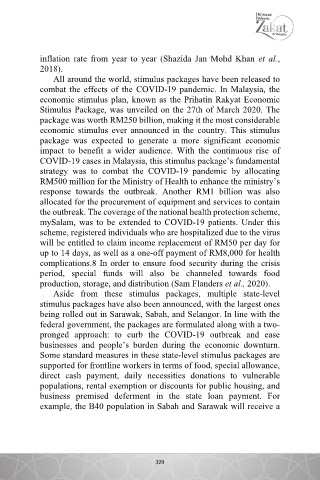Page 336 - Dimensi Baharu Zakat di Malaysia
P. 336
© DIMENSI BAHARU ZAKAT DI MALAYSIA
ISBN 978-967-2959-04-5
inflation rate from year to year (Shazida Jan Mohd Khan et al.,
2018).
All around the world, stimulus packages have been released to
combat the effects of the COVID-19 pandemic. In Malaysia, the
economic stimulus plan, known as the Prihatin Rakyat Economic
Stimulus Package, was unveiled on the 27th of March 2020. The
package was worth RM250 billion, making it the most considerable
economic stimulus ever announced in the country. This stimulus
package was expected to generate a more significant economic
impact to benefit a wider audience. With the continuous rise of
COVID-19 cases in Malaysia, this stimulus package’s fundamental
strategy was to combat the COVID-19 pandemic by allocating
RM500 million for the Ministry of Health to enhance the ministry’s
response towards the outbreak. Another RM1 billion was also
allocated for the procurement of equipment and services to contain
the outbreak. The coverage of the national health protection scheme,
mySalam, was to be extended to COVID-19 patients. Under this
scheme, registered individuals who are hospitalized due to the virus
will be entitled to claim income replacement of RM50 per day for
up to 14 days, as well as a one-off payment of RM8,000 for health
complications.8 In order to ensure food security during the crisis
period, special funds will also be channeled towards food
production, storage, and distribution (Sam Flanders et al., 2020).
Aside from these stimulus packages, multiple state-level
stimulus packages have also been announced, with the largest ones
being rolled out in Sarawak, Sabah, and Selangor. In line with the
federal government, the packages are formulated along with a two-
pronged approach: to curb the COVID-19 outbreak and ease
businesses and people’s burden during the economic downturn.
Some standard measures in these state-level stimulus packages are
supported for frontline workers in terms of food, special allowance,
direct cash payment, daily necessities donations to vulnerable
populations, rental exemption or discounts for public housing, and
business premised deferment in the state loan payment. For
example, the B40 population in Sabah and Sarawak will receive a
328
329

